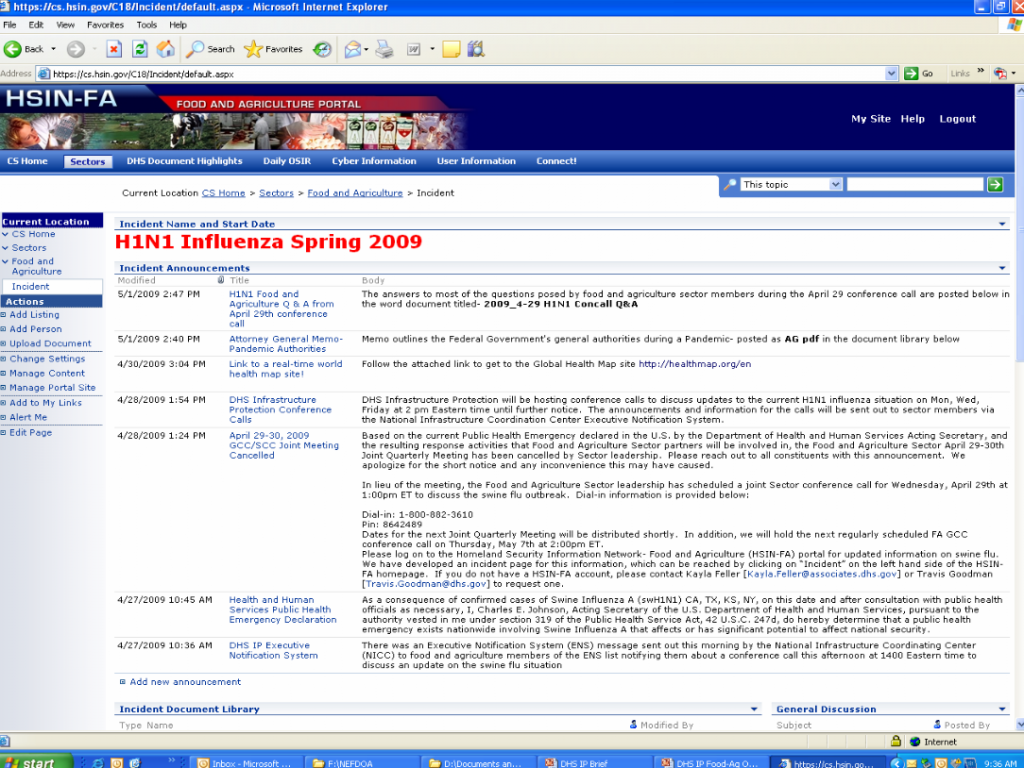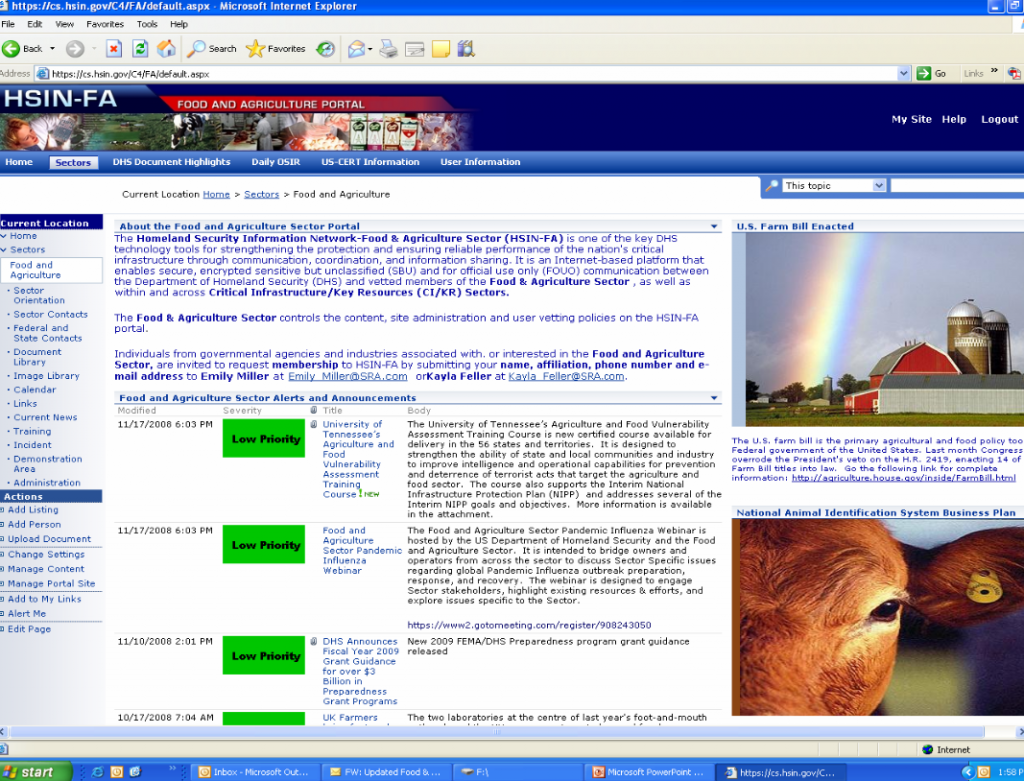 Food and Agriculture Sector Government Coordinating Council
Food and Agriculture Sector Government Coordinating Council
- 18 pages
- For Official Use Only
- October 2009
Food & Agriculture Sector Specialist
- Intergovernmental Position -Detailed from the state to provide private sector input–John D. Martin –Lead Food & Agriculture Sector Specialist–Travis Goodman and Greg Christy –previously in IP
- Provide a state perspective
- Provide subject matter expertise to the Food & Agriculture Sector Government Coordinating Council (GCC)
- Support information sharing –HSIN-FA–FoodSHIELD
…
Homeland Security Authority
- The Homeland Security Actof 2002 established an Assistant Secretary for Infrastructure Protection (IP), responsible for assessing vulnerabilities of critical infrastructures and key resources (CIKR) and developing a comprehensive national plan.
- The Homeland Security Presidential Directive (HSPD-7) established national policy for Federal departments and agencies to identify and prioritize the United States’CIKR and to guard against efforts to undermine or exploit those sector assets. (Currently going through review and re-write)
- Homeland Security Presidential Directive (HSPD-9) established a national policy to defend the agriculture and food system against terrorist attacks, major disasters, and other emergencies.
- HSPD-7 and HSPD-9and the National Infrastructure Protection Plan (NIPP)provide the overarching framework for a structured partnership between government and the private sector for protection of CIKR
–The NIPP provides the unifying structure for the integration of existing and future CIKR protection efforts into a single national program
–18 CIKR sectors…
Food and Agriculture Security Partners
DHS coordinatesthe overall national effort to enhance CIKR protection and resiliency through the implementation of the NIPP; With guidanceprovided by Homeland Security, these agencies shall collaborate with all relevant partners to prevent, deter, and mitigate deliberate efforts to destroy, incapacitate, or exploit the food and agriculture sector
- Government Coordinating Council (GCC) –the council which provides effective coordination of agricultural security and food defense strategies and activities, policy, and communication across government and between the government and the private sector to support the nation’s homeland security mission
–Sector Specific Agency (SSA) –the designated sector specific agencies for food and agriculture are the USDA and DHHS (FDA)
–21 Food & Agriculture GCC members
- Sector Coordinating Council (SCC) –created by private industry to serve the sector’s counterterrorism and security interests; represents the scope,breadth, depth, and interdependence of the U.S. Food and Agriculture Sector (i.e., owners, operators, associations)
–28 Food & Agriculture SCC members
…
Food and Agriculture Criticality Assessment Tool (FASCAT)
- Food & Agriculture GCC partnered with the University of Minnesota’s National Center for Food Protection and Defense (NCFPD) to develop FASCAT
- Assessment tool to assist states in determining and documenting their most critical food and agriculture infrastructure
- FASCAT provides:
–A means to identify key state commodity chains or food distribution systems
–A consistent method to prioritize state or private sector vulnerabilities and possible protective strategy development
–Document and characterize a state’s food & agriculture sector risk profile
–An effective response to future DHS National Data Calls for information on critical Food & Agriculture Infrastructure
–Intended tool for getting Food & Agriculture systems considered for Level (Tier) II or otherwise eligible for future DHS funding
–Version 2.0 is currently in development and is expected to be released later this year, providing a web hosted option for secure enhanced data entry…
Homeland Infrastructure Threat & Risk Analysis Center
(HITRAC)
–HITRAC is Homeland Infrastructure Threat & Risk Analysis Center –it is the DHS fusion center that analyzes the data from all 18 sectors
–Nationally Critical Lists –Level I and Level II
–Regionally Critical Lists –Sector Lists, State Lists, and Foreign Lists
–Meeting in Chicago in November 2009 soliciting input from SMEs(subject matter experts) to obtain input on how to improve the criticality assessment of food and agriculture systems
(Nov date postponed -rescheduling)Food & Agriculture Sector Information Sharing
- Establish a sustained integrated web-based systems approach that provides effective Communication, Coordination, Collaboration, Education and Training mechanisms for the Food and Agriculture Sector that leverages a comprehensive “real time”infrastructure awareness and maintains relevant information sharing with all sectors
FoodSHIELD
HSIN-FAUtilizing Web-based Platforms for Information Sharing
- FoodSHIELD–primary platform used for routinecommunications in a steady state
–It is a web-based platform developed as a comprehensive infrastructure supporting the work of the various laboratories and regulatory agencies that protect and defend our food and agriculture resources
–Working groups, webinars, etc.
- Homeland Security Information Network –Food & Agriculture(HSIN-FA)–used for communications during an incident (Incident page)and for sharing sensitive information
–It is an internet-based platform that enables secure encrypted sensitive but unclassified (SBU)and for official use only (FOUO) communication between the DHS and vetted members of the Food and Agriculture Sector, as well as within and across CIKR sectors.
- Homeland Security Information Network –Critical Sectors (HSIN-CS)–used for sharing information with other CIKR sectors during an incident or in a steady state
–Portal designed to enhance the protection, preparedness, and crisis communication and coordination capabilities of the nation’s 18 critical infrastructures


